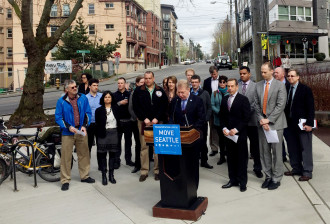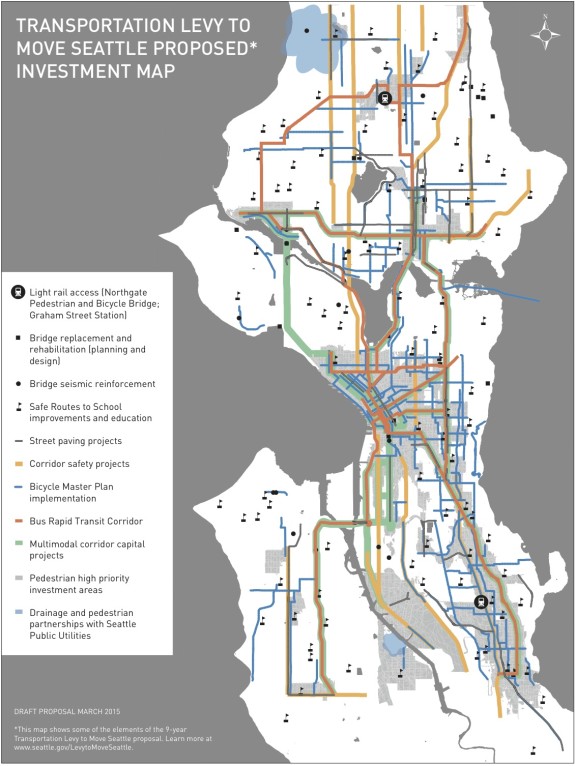 Mayor Ed Murray announced a $900 million transportation levy today, two and a half times as big as the Bridging the Gap levy passed in 2006.
Mayor Ed Murray announced a $900 million transportation levy today, two and a half times as big as the Bridging the Gap levy passed in 2006.
The mayor’s initial draft (PDF) of Move Seattle will now go through a public feedback phase through April. The mayor will then submit his final version to the City Council, who will have until August to submit their version to get it on the ballot for a November vote.
Affordability is one of the primary goals outlined in the draft proposal. How does a tax increase help affordability, you ask? Murray told the crowd and press gathered in front of the Bullitt Center that the plan would invest in “more affordable transportation options” like walking, biking and transit.
“We want to lower the out of pocket expenses for people,” said SDOT Director Scott Kubly, noting that on average 17 percent of people’s expenses go to transportation costs. Being able to get around more affordable is a huge piece to reducing the cost of living in the city.
And thanks to a growing tax base, the increased levy size will be split among more people. So while the levy size will be 147 percent larger than Bridging the Gap, the cost for property owners will only be 112 percent higher ($275/year for median household of $450,000 vs $130/year under Bridging the Gap). The increased funding will also help the city compete for grants that could total an additional $2 billion, according to the Move Seattle draft proposal.
It will be interesting to see how this proposal mixes with citywide conversations about affordable housing, which the Community Housing Caucus called an “emergency” in a recent report.
So what’s this mean for bikes?
“The mode wars are over,” Murray declared at the opening of the press conference. This is a phrase he has used consistently in recent months when he talks about his “integrated” transportation plan.
But of course, there are still a ton of unfriendly streets where people on bikes don’t feel welcome or safe. On a policy level, hostility between transportation modes makes no sense. But on the street level, our roadways can still feel very hostile to anyone outside a car.
Perhaps most notably is what’s not in the plan: Lots of new highway-style roads or big road expansion projects. This is a recognition that we cannot build our way out of Seattle’s car traffic problem, and there’s simply no way to widen our streets much further. If Seattle does not provide its growing population more options to get around, traffic will only get worse for everyone, said Mayor Murray during the press conference.
There’s are some freight projects included, like a pricey rail overpass at S Lander St and a rebuild of E Marginal Way (which, of course, is also on the Bike Plan as a key route to West Seattle and Georgetown). There are also a bunch of transit projects that we won’t get into here.
The plan includes funding for improving sidewalks, curb ramps and crosswalks. There’s also funding for Safe Routes to School that would create at least one safe route to every public school in Seattle (and a bunch of private ones, too). But Murray noted that fulfilling the city’s need for sidewalk work would cost double or triple the amount he is proposing.
The mayor’s proposal claims to complete half of the Bicycle Master Plan. Since it is a nine-year levy, that would theoretically put implementation of the 20-year bike plan on schedule.
More specifically, the levy would fund 50 miles of protected bike lanes (of 102 proposed) and 60 miles of neighborhood greenways (of 239 proposed). It would also include funding to build the Northgate bike/walk bridge and complete the Burke-Gilman Trail Missing Link in Ballard, which are big ticket items. See this post for more details on the projects at the top of the city’s priority list.
The city would also conduct 12 – 15 road safety corridor projects, complete 7 – 10 mutimodal corridor projects and repave 250 lane miles on busy streets. Many of these projects could be opportunities to implement elements outlined in the Bike Master Plan.
Here’s a look at a composite map of these investments:
This is a great starting place for a transportation levy. If passed as is, it could provide the funding Seattle needs to remain a leader as a bike-friendly American city.
But it could also be an opportunity to accelerate Bike Plan implementation. With even further investment, we could turn that 20-year plan into a 10- or 15-year plan, a desire that’s been voiced by bike advocates and city leaders ever since it was adopted.
“I want it built out while I can use it,” said City Council Transportation Chair Tom Rasmussen in the spring of 2014. “20 years is a heck of a long time to wait to get it done.”
The final result for bike mobility, comfort and safety is in the details, so the metrics for monitoring success needs to be specific. Do those 50 miles of protected bike lanes include complete bike route connections, including all the costly-yet-vital intersection redesigns? It’s easy to build 50 miles of bike lanes that disappear at every major intersection like most of the city’s bike lanes do currently. Will the multimodal corridor projects include bike lanes where needed and outlined in the Bike Master Plan? Will repaving projects include planned bike lanes and neighborhood greenway crossings?
In other words, will Move Seattle provide enough funding to make sure families and people of all ages and abilities in every Seattle neighborhood feel comfortable walking and biking to get around?
Stay tuned for more reporting as we dive further into the details and as the City Council makes their changes. More details and materials (including a video with a super soothing soundtrack) on the Move Seattle webpage.
If you want to get involved or ask questions, there are a bunch of opportunities listed on the city’s website, including these community meetings:
3/28/15
Southeast Seattle Community Conversation
10 am – 12 pm
New Holly Gathering Hall
7054 32nd Ave S
Seattle, WA 98118
3/30/15
North Seattle Community Conversation
6 pm – 8 pm
Roosevelt High School
1410 Northeast 66th St
Seattle, WA 98115
3/31/15
West Seattle Community Conversation
6 pm – 8 pm
West Seattle High School
3000 California Ave SW
Seattle, WA 98116
UPDATE: There’s also an online survey to collect feedback.









Comments
9 responses to “Move Seattle transportation levy could build half of city’s Bike Plan”
These seem like sensible questions about whether the investments mattered will matter. What wouldn’t be sensible would be to spend significant amounts of money to upgrade a bunch of bikeways just for show and then to leave weak links every 300 feet.
Tom, what do you mean by “could also be an opportunity to accelerate Bike Plan implementation”? Would that be under the plan as proposed here or under some modification of it?
“With even further investment”
I’m pushing for more because I think Seattle is thirsty for more.
But it’s important to note that this is itself a huge increase in bike plan funding, and it’s not the only source of those funds. Grants (regional, state, federal) also add to the pool, as does the City Council’s general transportation budgeting process. And there are chances to build the bike plan by coupling improvements with other work. So this levy building a big piece of the master plan is a big deal. I don’t want to downplay how exciting that is.
This is great news, especially for a quickly growing city. One of the first things people will do here is get their bike out. If they’re freaked out by something early on, it might be years before they try again (I know, I’ve been working to convince some friends that biking really can be safe). Better to make sure people never have that frightening experience.
This is good news and a good start. I have to say I think Mayor Murray does a really good job of brining coalitions together for policy change/implementation. I think this is a big step in the right direction and will create demand for more infrastructure and bike/ped friendly laws and design.
It’s so refreshing to see positive comments on this blog. Go to the seattle times or PI and see what people are posting and you’d think that we’re living in 1955 with a bright future of freeways through every urban center.
Color me skeptical,
This is an ambitious plan, as in vaulting ambition o’erleaping itself. Take one of the map’s tiny squiggles near and dear to my heart: the extension of the bike lane at the top of the Admiral climb in West Seattle,…
They built an uphill bike lane as far as the width of the road would allow and then, right where it actually gets dangerous the bike lane ends and they slapped down some sharrows. Why? Because that’s all the width of the road allows. This road is already bumper to bumper in the evening rush hour (and far beyond that in the summer Alki beach season), if they re-channelize it, traffic, including buses will be stopped all the way down the hill for hours per day. If they don’t re-channelize it then they’ll have to take out the planting strip and sidewalk on at least one side of the street.
That’s just one of a hundred places where our rights-of-way are bumping up against capacity. Multiply the likely local resistance and backlash by a hundred and I don’t really see a lot of these projects going forward.
I know the standard here is All Ages And Abilities, I’ve kvetched about that before, I don’t think it’s the right standard for motorists or for cyclists; having said that I’m generally okay with the roads as they are. I’d just like a little courtesy from my fellow road users, and I think dollars spent on education and enforcement would go a lot further than they would on bollards and re-striping.
[…] only ones who wrote about the Mayor’s new $900m, 10-year Bridging the Gap levy. Seattle Met, Seattle Bike Blog, Capitol Hill Seattle Blog, and Seattle Transit Blog each took a whack at the […]
[…] Ed Murray’s Move Seattle levy includes funding to complete the trail. That makes him the third mayor in a row to budget for this […]
[…] have funding for any large changes yet, but it could have a good shot at funding if voters approve the Move Seattle levy in […]